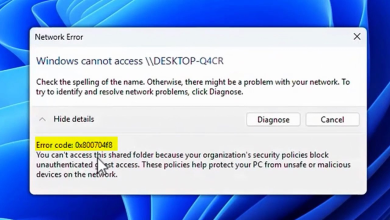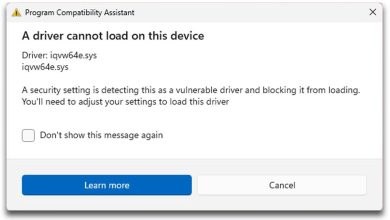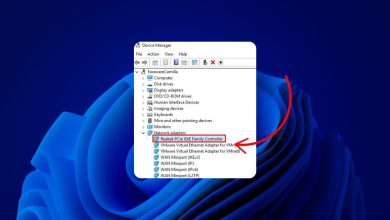Fix ‘The DNS Server isn’t responding’ Error in Windows
When using the network connections troubleshooter feature on Windows, some users are shown an error that says, The DNS Server isn’t responding. This error indicates an issue with the DNS Server Setting of the system.
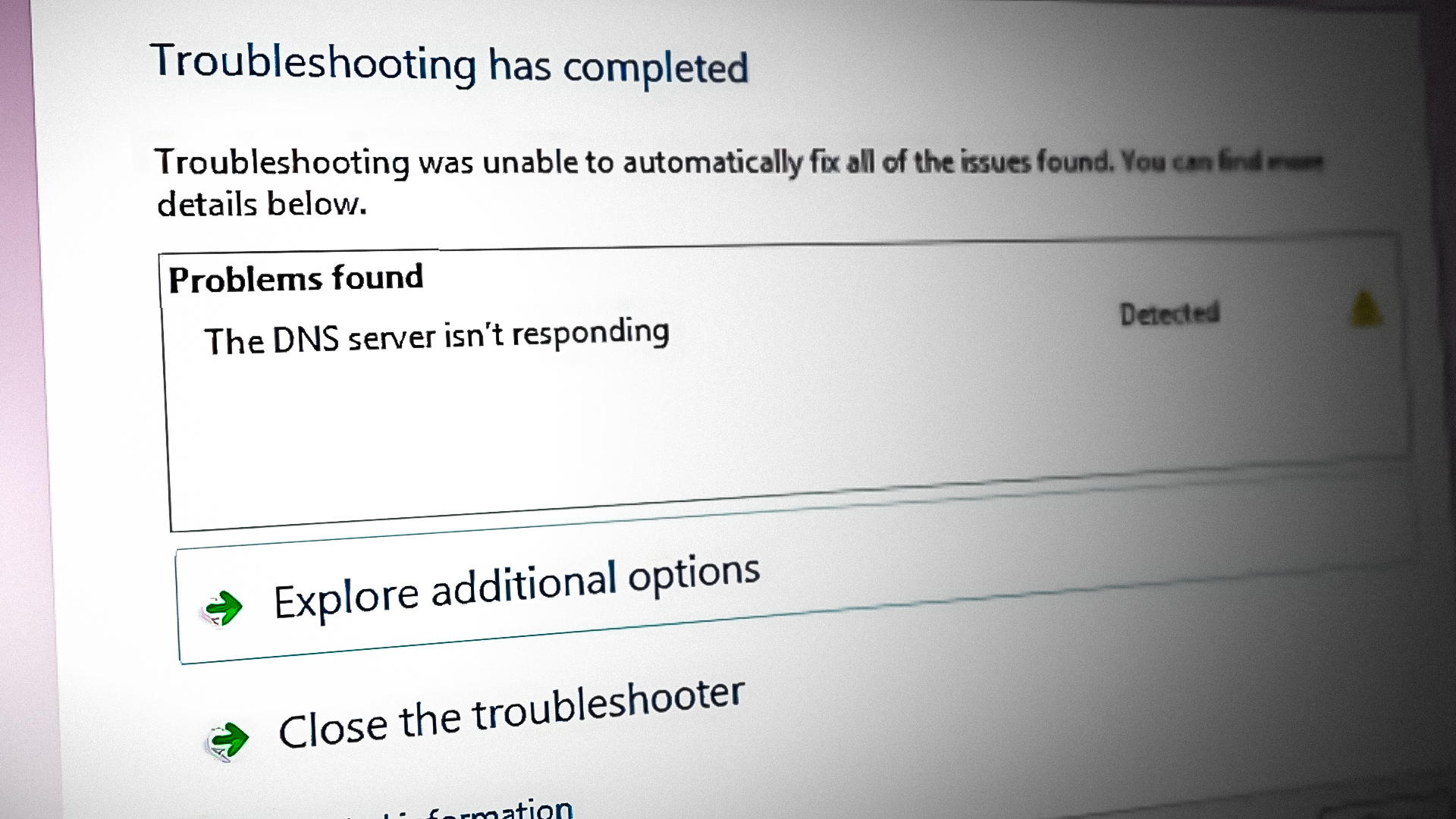
To help you resolve this error, we’ve prepared this guide which outlines all the possible causes of this error and gives the best solution for each cause.
Why Does “The DNS Server Not Responding” Error Occur?
This error is caused by an issue with your system’s Domain Name System (DNS) Server. Each time you try to load a web page on a browser, your system’s DNS Server must first translate the Domain Name (URL) of the web page into an IP Address.
Once the DNS Server has obtained the IP Address of the web page, your system can load it on your browser. So without a proper DNS Server, your system will not be able to load any web pages, and your browser will tell you that it cannot find their DNS address.
And if an issue arises with the DNS Server being used by your system, you will encounter the “DNS Server Not Responding” error.
This error can significantly impact your internet connection, and it may even completely prevent you from being able to load any websites on your browser.
Multiple factors can cause issues with your DNS Server. Your DNS Server might be offline or outdated, your DNS cache might be corrupted, or you might have improper network configurations.
Luckily, many methods exist to solve this error, some of which only take a few minutes to perform. Below, we’ve listed every possible solution for this error.
1. Try using internet on another device
Try to load a website on another device connected to the same network. If you do not have another PC available, you can use your phone and connect its Wi-fi to the same network as your current device. This will allow you to check your internet connection status quickly.
If you do not experience the same error on the other device, you will have confirmed that the issue is on your end, and you can fix it through the solutions we’ve listed in this guide.
However, if you experience the exact same error on other devices as well, the issue is most likely originating from your Internet Service Provider’s (ISP) end. If this is the case for you, contact your ISP and tell them about the issue to get it solved.
But before you call your ISP, you should try using an Ethernet Cable to connect your device to the router instead of using Wi-Fi.
2. Power Cycle your Router and Modem
To power cycle your router and modem, follow the steps we’ve listed below:
- Unplug the router and modem’s power brick from the electric outlet.
- Wait around 2 to 3 minutes.
- Plug the power bricks back into the electric outlets.
- Wait until the router and modem have fully turned on.
You can try restarting your computer as well.
After power cycling your router and modem, open any browser (such as Google Chrome) and load a website. If the website successfully loads without the DNS error, power cycling is the solution to your problem.
But if you continue to experience the error even after the power cycle, move on to the next solution we’ve listed below.
3. Flush DNS Cache
This corrupted/outdated DNS cache leads to all types of DNS server errors. Therefore, the next best solution for this error is to wipe your system’s DNS cache, also known as “Flushing the DNS.”
Follow the steps written below to flush your DNS cache:
- Press the Windows key on your keyboard to open the Start menu.
- Type “Command Prompt.”
- Click on the “Run as administrator” option.

Opening Command Prompt as administrator - In the Command Prompt window, type the following commands one by one and press enter after each command.
ipconfig /flushdns ipconfig /registerdns

Flushing DNS - Restart your PC.
Once you’ve entered this series of commands into Command Prompt, your DNS cache will be flushed and renewed. Try loading a webpage after entering these commands to see if they fixed the error. If your internet connection is still not fixed, continue with the next solution below.
4. Change to a Different DNS Server
If flushing your DNS cache did not fix the error, the next solution is to switch over to a new DNS Server. This method successfully fixes most DNS Server related issues.
The two best DNS Servers available on the internet are Cloudflare and Google. These DNS Servers provide users with great connection speeds, and they rarely ever encounter issues.
If you want to change your DNS Server to Cloudflare DNS or Google DNS, follow the steps written below:
- Press the Windows key on your keyboard to open the Start menu.
- Type “Control Panel” in the search bar and hit enter.

Opening Control Panel - Go to Network and Internet > Network and Sharing Center.
- Click on your Connection (Ethernet/Wifi).
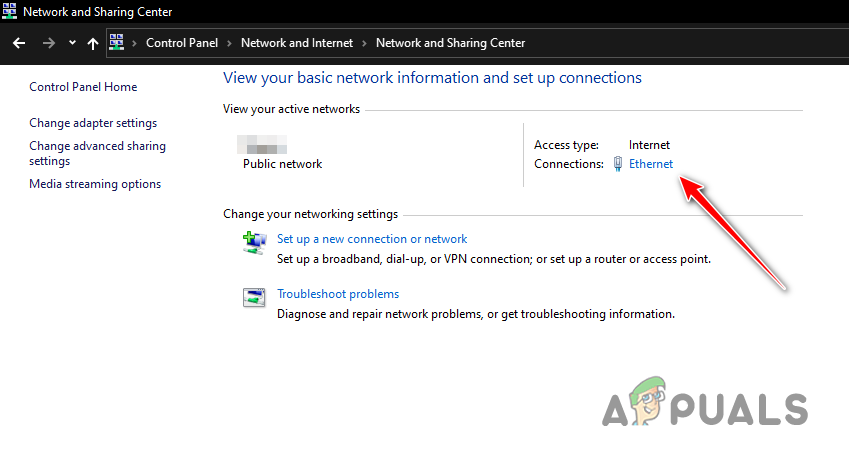
Opening Ethernet menu - Click on the Properties option.

Opening Ethernet properties - Click on Internet Protocol Version 4 (TCP/IPv4).
- Click on the Properties button.
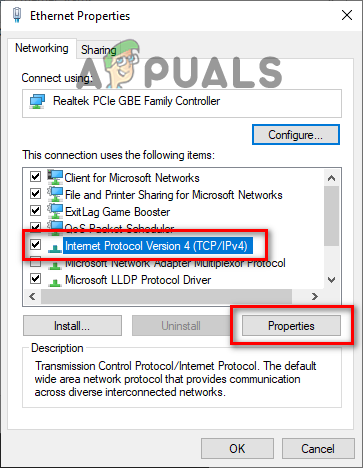
Opening Internet Protocol Version 4 properties - Click on the “Use the following DNS Server addresses” option to change your DNS Setting to manual.
Type 1.1.1.1 in the Preferred DNS Server section and 1.0.0.1 in the Alternate DNS Server section to switch to the Cloudflare DNS Server.
Type 8.8.8.8 in the Preferred DNS Server section and 8.8.4.4 in the Alternate DNS Server section to switch to the Google DNS Server.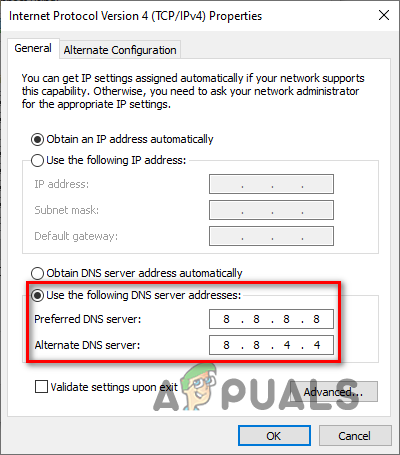
Changing DNS Server - Click the OK button.
After changing the DNS Server, open your browser and see if you can now connect to the internet. If this did not fix your issue, don’t worry; we’ve listed more solutions below.
Note: If you were already manually using an optimized DNS Server, such as Google or Cloudflare, changing the DNS Server Setting back to automatic might fix your issue.
5. Disable Antivirus and Firewall Temporarily
Antivirus and Firewall programs can sometimes conflict with the DNS Server being used by our devices. Your Antivirus software and/or Windows Firewall could flag your DNS server as unsafe and prevent it from performing its required tasks.
Follow the steps below to disable your Antivirus program temporarily:
- Press the Windows key on your keyboard to open the Start menu.
- Type “Windows Security” in the search bar and hit enter.
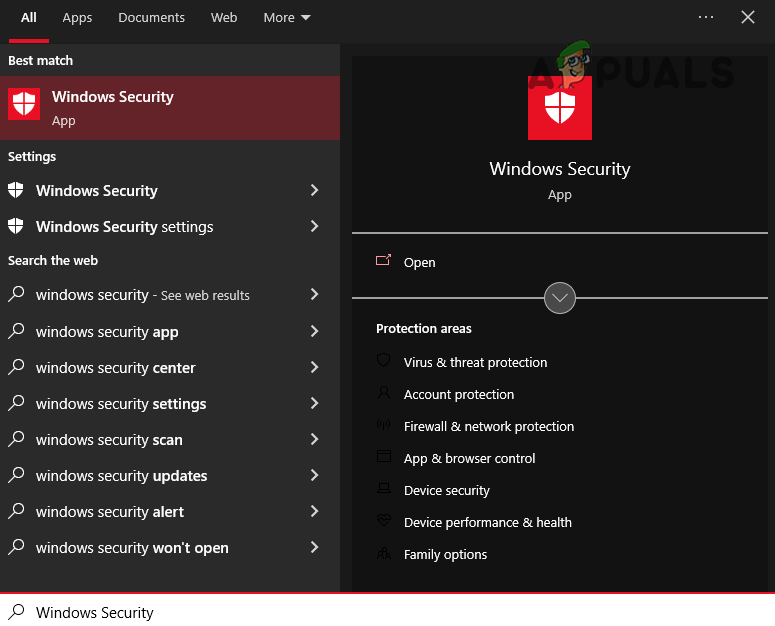
Opening Windows Security - Click on “Virus & threat protection” on the left.
- Click on the blue “Open app” option in the middle of the menu.

Disabling Antivirus
Now, Follow the steps below to disable your Windows Firewall temporarily:
- In the Windows Security menu, click on “Firewall & network protection” on the left.
- Click on the active network.
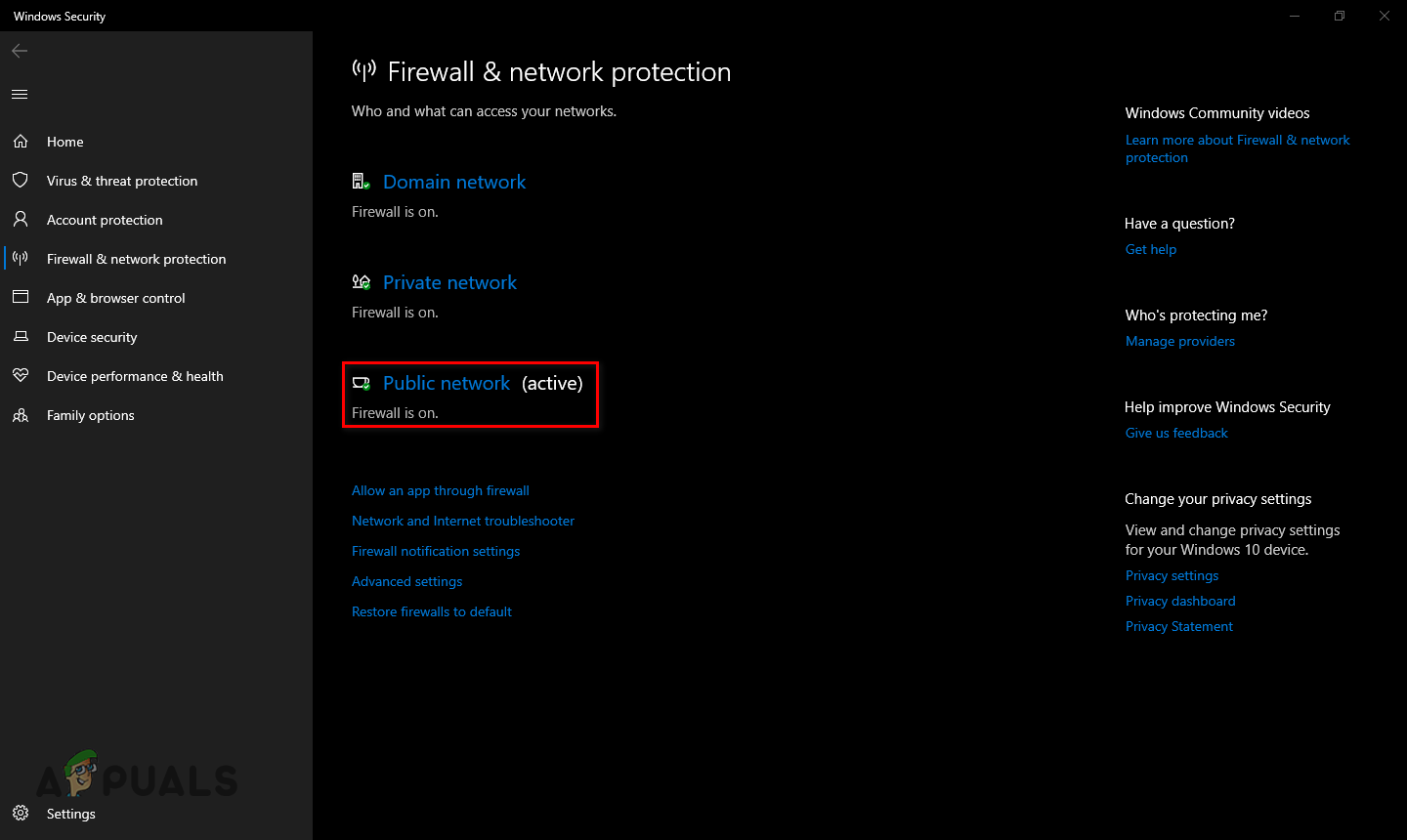
Opening Firewall Settings - Disable Microsoft Defender Firewall.
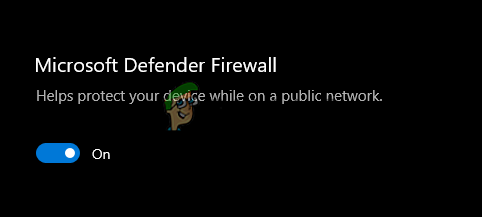
Disabling Firewall
If you have a third-party Firewall installed on your system, remember to disable it too. Once you’ve disabled the Antivirus and Firewall programs, see if the DNS problem is fixed.
If this method fixes your issue, you must install a different Antivirus program to protect your system. If you’re unsure which one to install, check out our list of the 5 best Antivirus programs.
6. Disable IPv6 and Set Network Address to 0
After disabling IPv6, you should also set your Network Address to 0. Your Network Address is related to your Network Adapter, and setting its value to 0 will refresh the address, which may help fix your connection.
To disable IPv6, follow the steps we’ve listed below:
- Press the Windows key on your keyboard to open the Start menu.
- Type “Control Panel” in the search bar and hit enter.
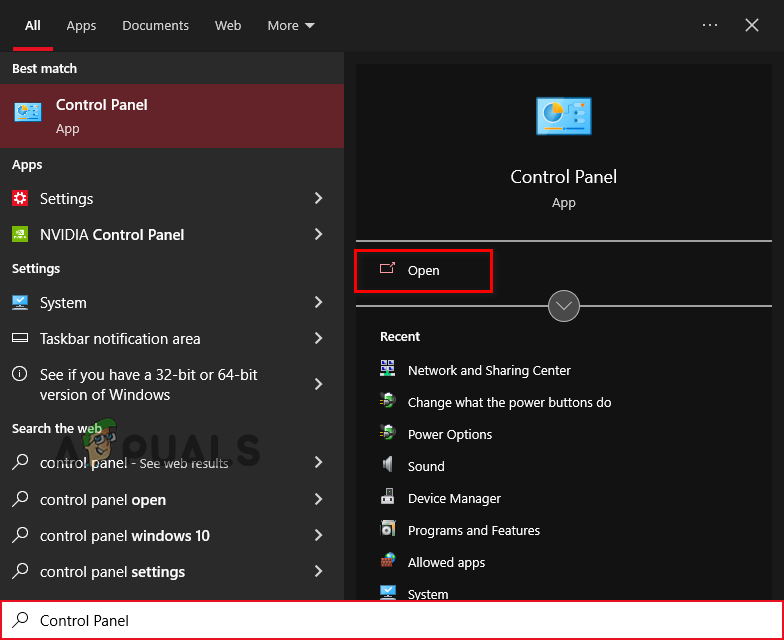
- Go to Network and Internet > Network and Sharing Center.
- Click on your Connection (Ethernet / Wi-Fi).

- Click on the Properties option.

- Remove the checkmark next to Internet Protocol Version 6 (TCP/IPv6).
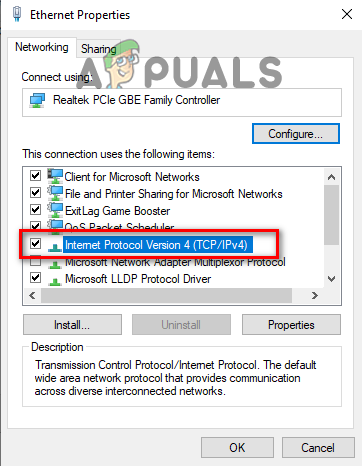
Disabling Internet Protocol Version 6 - Click on OK.
- Click on the “Configure” button in the Ethernet Properties window.
- Navigate to the Advanced tab.
- Scroll down to the “Network Address” option.
- Click on the “Value” option.
- Set the Value to 0.

Setting Network Address to Zero - Click on OK.
- Restart your PC.
After your PC restarts, check if disabling IPv6 has fixed your issue. If it has not, you should re-enable it in the same way.
7. Disable Microsoft Wi-Fi Direct Virtual Adapter
If you have the Microsoft Wi-Fi Direct Virtual Adapter (also known as the “Microsoft Virtual Miniport Adapter“) enabled on your system, it may be a major cause of this error. The purpose of this adapter is to allow you to create a virtual network on your computer.
But according to tech experts, having this adapter enabled may lead to network issues, specifically with the system’s DNS Server.
Follow the steps below to disable the Microsoft Wifi Direct Virtual Adapter:
- Press Windows Key + R simultaneously to open the Run dialog box.
- Type devmgmt.msc in the search bar and hit enter.
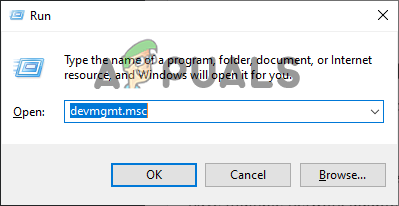
Opening Device Manager through the Run dialog box - Click on the “View” option at the top of the Device Manager window and select the “Show hidden devices” option.
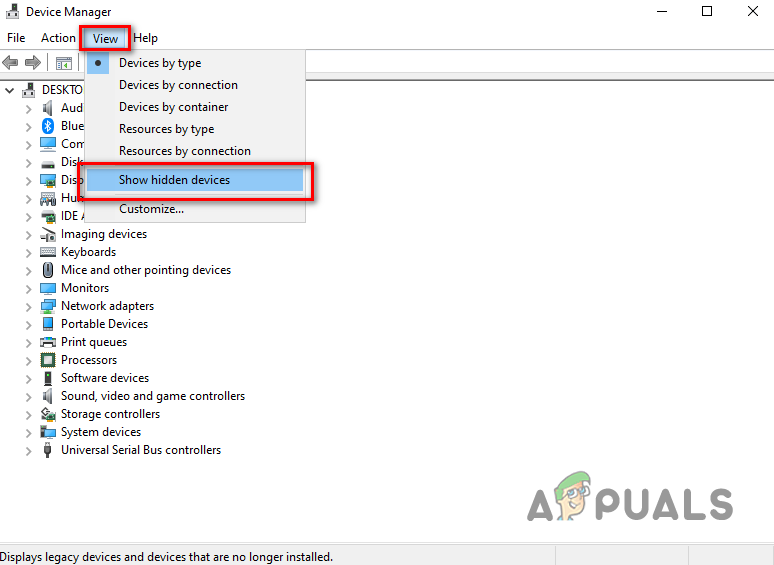
Showing hidden devices in Device Manager - Click the small arrow next to “Network Adapters” to expand it.
- Right-click on “Microsoft Wifi Direct Virtual Adapter.
- Click on “Disable.”
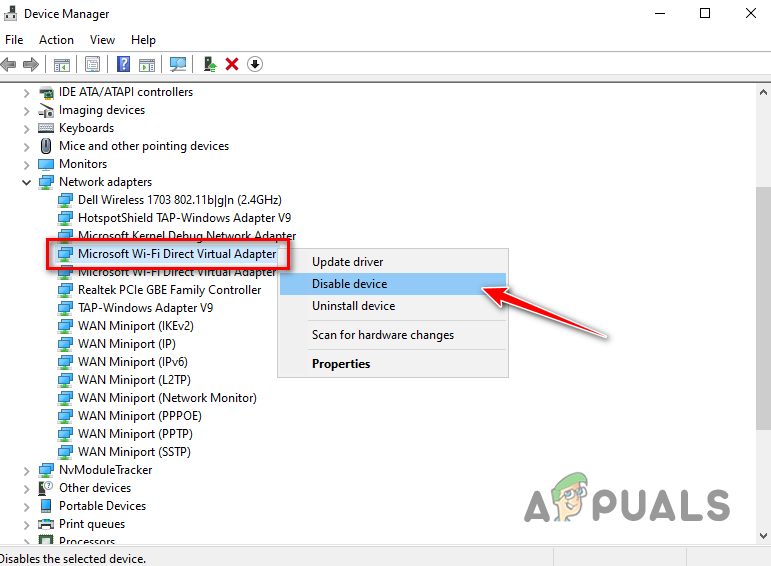
Disabling Microsoft Wifi Direct Virtual Adapter - Restart your system.
8. Update your Network Adapter Driver
An outdated Network Driver can lead to several internet connectivity errors. So if you’ve not updated your system’s Network Driver for a long time, it might be the root cause of the error you’re facing.
To update your Network Driver, you must first figure out which network adapter you are using, as most users have multiple network adapters installed on their system.
Follow the steps below to determine what network adapter you are using:
- Press Windows Key and I at the same time to open the Settings Menu.
- Click on the “Network & Internet” option.
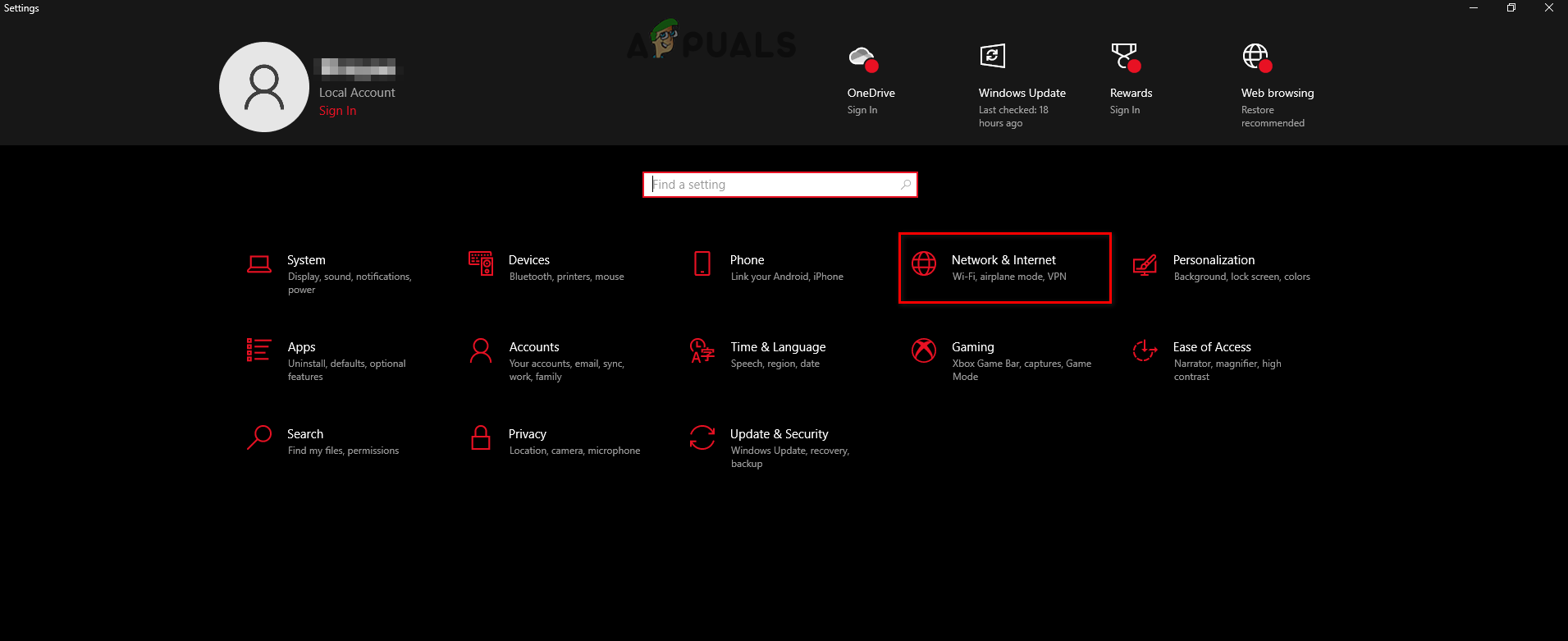
Opening Network and Internet Settings - Click on “Change adapter options” in the middle of the window.
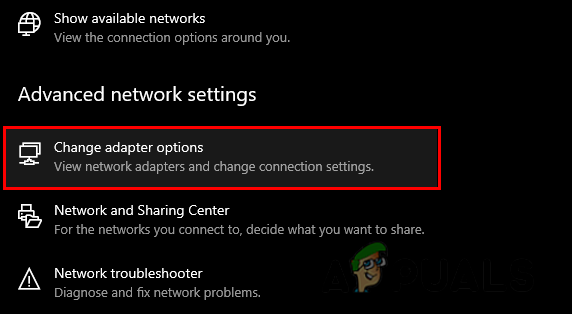
Change the adapter options - In the Network Connections window, determine what network adapter you are using by checking which one does not have an “X” mark next to it.

Selecting the appropriate network connection
Now that you know which network adapter your system is using, follow the steps below to update its driver:
- Open Device Manager.
- Click the small arrow next to “Network Adapters” to expand it.
- Right-click on the appropriate Network Adapter.
- Click on the “Update Driver” option.
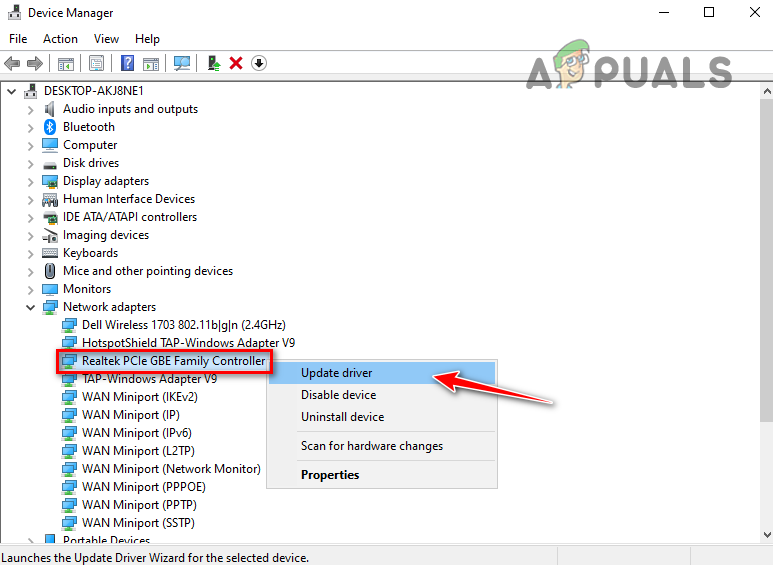
Updating network driver - Select “Search automatically for driver.”

Search Automatically For Driver - Wait until your network adapter driver has been updated.
- Restart your PC.
Note: If you encounter any error while updating the Network driver, follow this guide to fix your issue.
9. Reset Network Settings
The three major network settings that could be causing this issue are your system’s Winsock Catalog, IPv4 and IPv6, and your IP Address.
So the next solution to this issue is to reset these network settings. Note that this will not negatively impact your connection, so there’s no risk involved in resetting them.
9.1 Reset the Winsock Catalog
Follow the steps listed below to reset your computer’s Winsock Catalog:
- Press the Windows key on your keyboard to open the Start menu.
- Type “Command Prompt.”
- Click on the “Run as administrator” option.

- In the Command Prompt window, type the following command:
NETSH winsock reset catalog
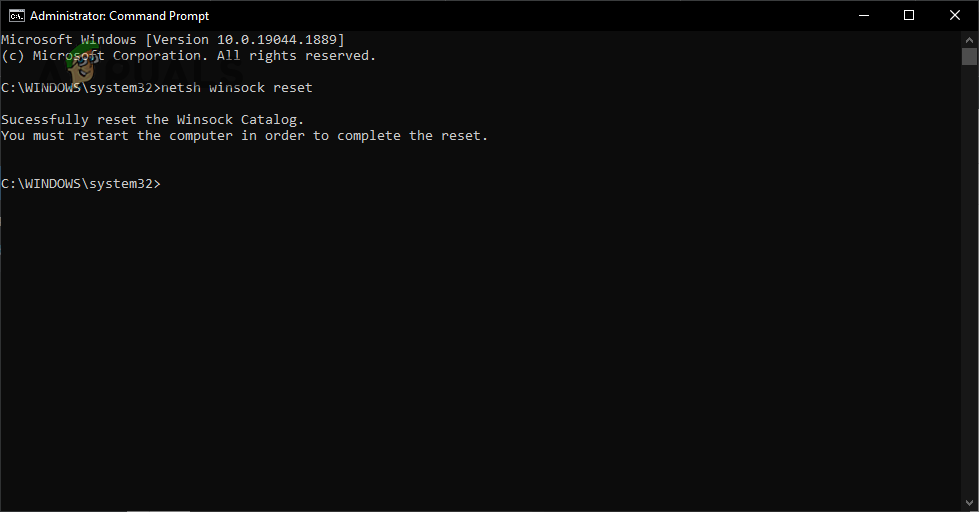
Resetting Winsock Catalog - Restart your PC.
9.2 Reset IPv4 and IPv6
The Internet Protocols of your system (IPv4 and IPv6) could be malfunctioning. You should reset them to guarantee they have no issues and are working as intended.
Note that if you’ve already disabled IPv6 in the previous solution, you only need to reset IPv4 as the other one is inactive.
Follow the steps listed below to reset IPv4 and IPv6:
- Open Command Prompt as Administrator.
- Type the following commands (one by one) and press enter:
NETSH int ipv4 reset reset.log NETSH int ipv6 reset reset.log

Resetting IPv4 and IPv6
9.3 Reset your IP Address
The final step of resetting your network settings is to reset your IP Address. This will assign a brand new IP Address to your device, which often solves different network issues.
Follow the steps listed below to reset your IP Address:
- Open Command Prompt as Administrator.
- Type the following commands (one by one) and press enter:
ipconfig /release ipconfig /renew

Resetting IP Address
After you’ve reset all these network settings, remember to restart your PC to ensure they come into effect. After restarting your PC, open your web browser and see if the error has gone away.
10. Perform a Clean Boot
Clean boot will allow you to determine whether a program, service, or driver is actually causing this error. And once you’ve figured that out, the next step will be to find that program.
Follow the steps listed below to perform a Clean Boot of your computer:
- Press Windows Key + R simultaneously to open the Run dialog box.
- Type msconfig in the dialog box and press enter.

- Click on the “Services” tab at the top of the System Configuration window.
- Put a checkmark next to the “Hide all Microsoft Services” option at the bottom left.

Hiding All Microsoft Services
Now, you must disable all the services listed in this window and press apply to save the changes made. After that, click on the “Startup” tab at the top and select the “Open Task Manager” option.
In Task Manager, navigate to the Startup tab and see which unnecessary applications are allowed to launch on startup. Right-click on all unessential applications and select the Disable option. Once you’ve disabled the applications, they will no longer automatically launch on your system’s startup.
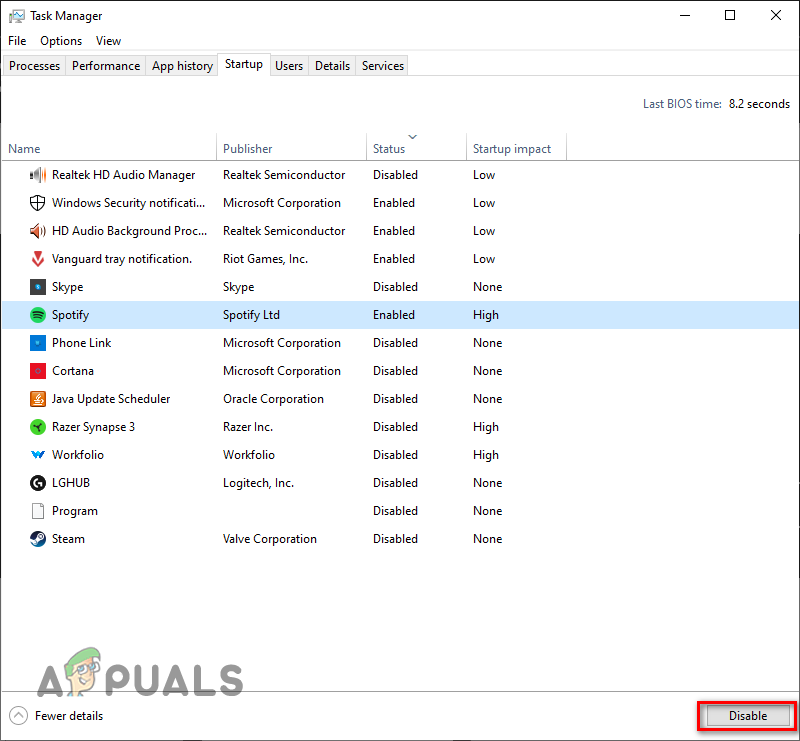
The final step in the clean boot process is to restart your PC. Once your PC is restarted, open a browser and try to load a web page.
If the web page loads successfully without any internet errors, one or more of the services/drivers/programs you disabled was the root cause of the issue.
But if you continue to experience the network error, skip the remaining portion of this solution and move on to the final solution listed below.
Now that you know that the error is being caused by some program or service, the next step is to determine which exact program or service is the culprit.
Open msconfig again and hide all the Microsoft services. Now, enable the disabled services in sets of 5. And each time you enable a set of services, restart your PC and check if the error has come back.
So you need to enable 5 services, restart your PC, check the status of the error, then enable 5 more services and repeat the process until the error comes back.
When the error finally starts occurring again, the culprit of the issue will be one (or more) of the last 5 services you enabled.
In this way, you will be able to quickly figure out the exact service that is causing the issue. Note that the issue can be caused by more than one service.
Once you’ve found the culprit(s), you should try updating or reinstalling them if you want to keep them active. But if you don’t need the erroneous services/programs, simply uninstall them from your system.
11. Perform a Network Reset
If you’ve tried all the solutions we’ve listed above and the error still hasn’t gone away, the final solution is to perform a network reset on your device.
Follow the steps listed below to perform a Network Reset on your device:
- Press Windows Key to open the Start menu.
- Type Settings and press enter.
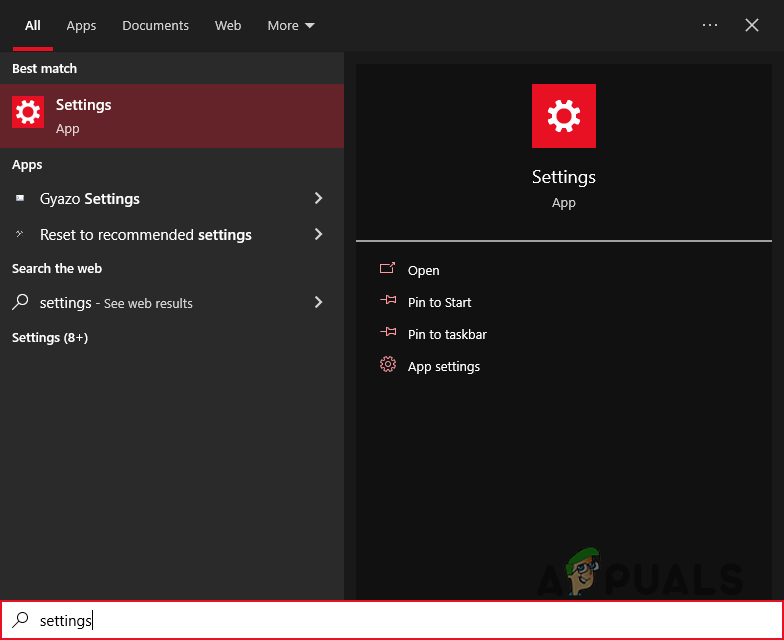
Opening Settings - Click on the “Network & Internet” option.

Opening Network and Internet Settings - Click on the red “Network Reset” option at the bottom of the menu.
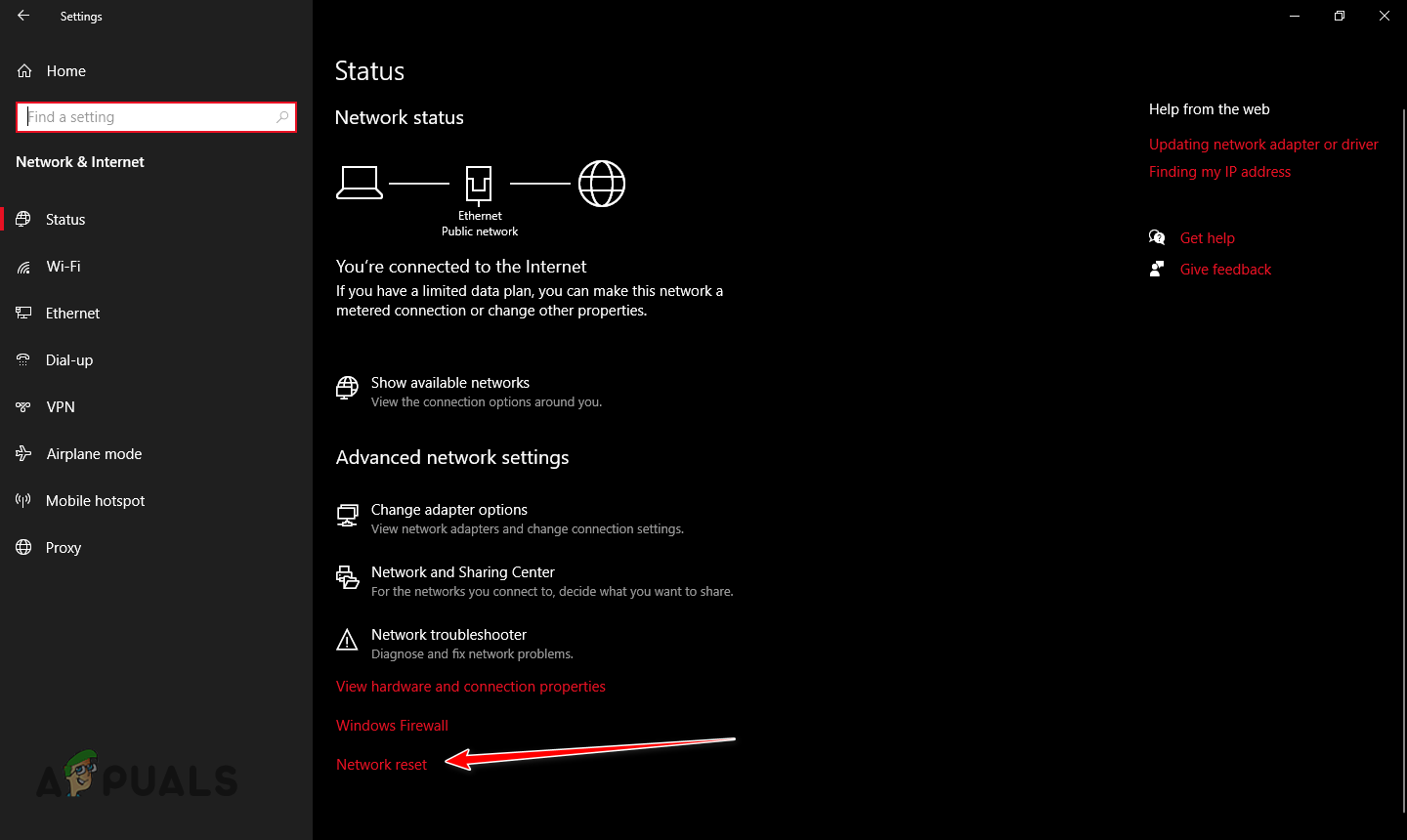
Selecting the Network Reset option - Click on the “Reset now” button.
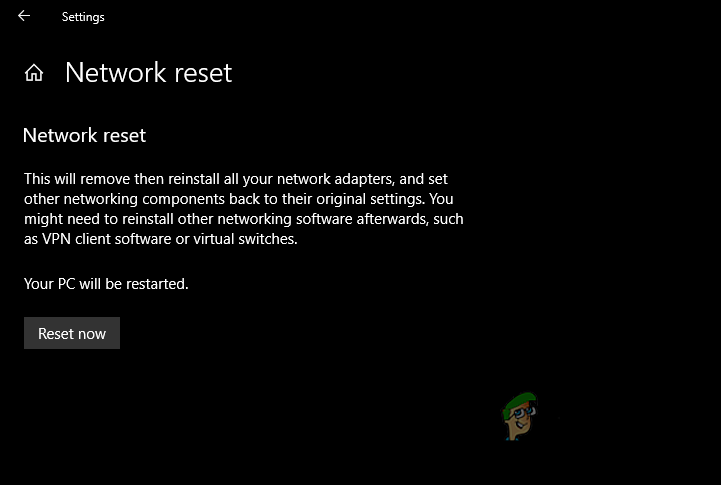
Resetting Network - Wait for your PC to restart.

